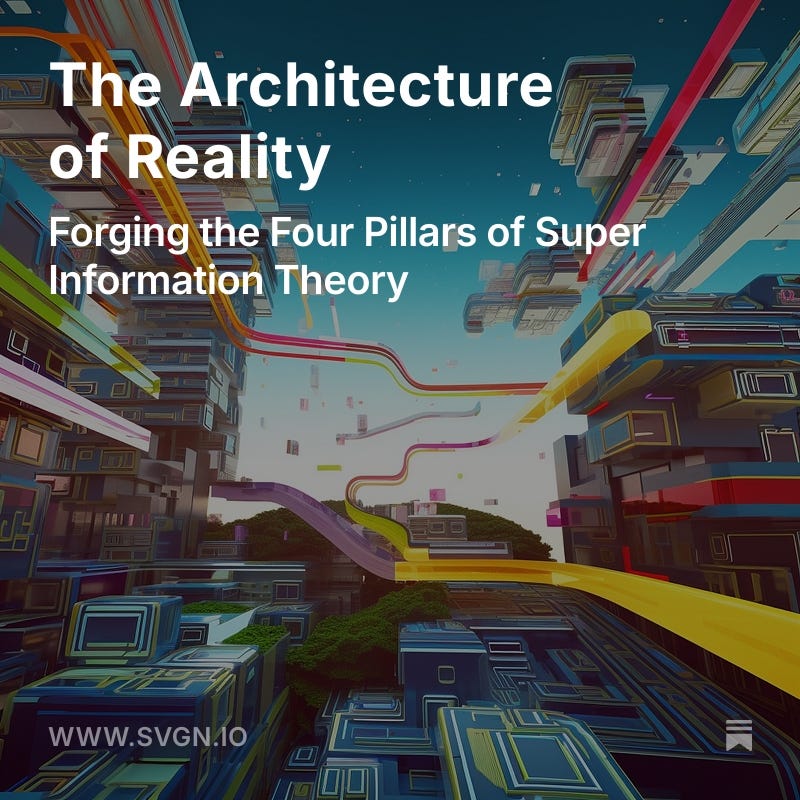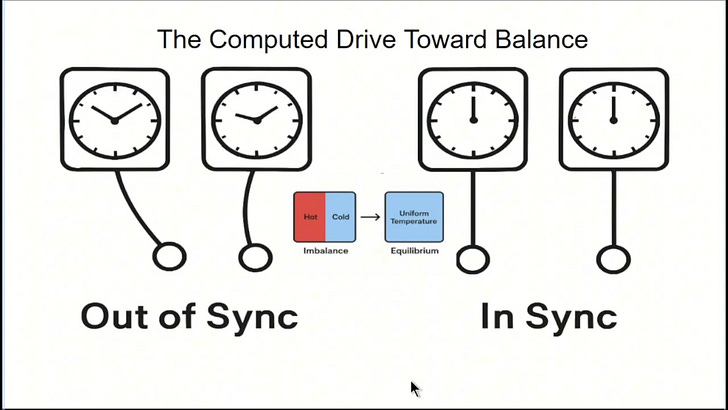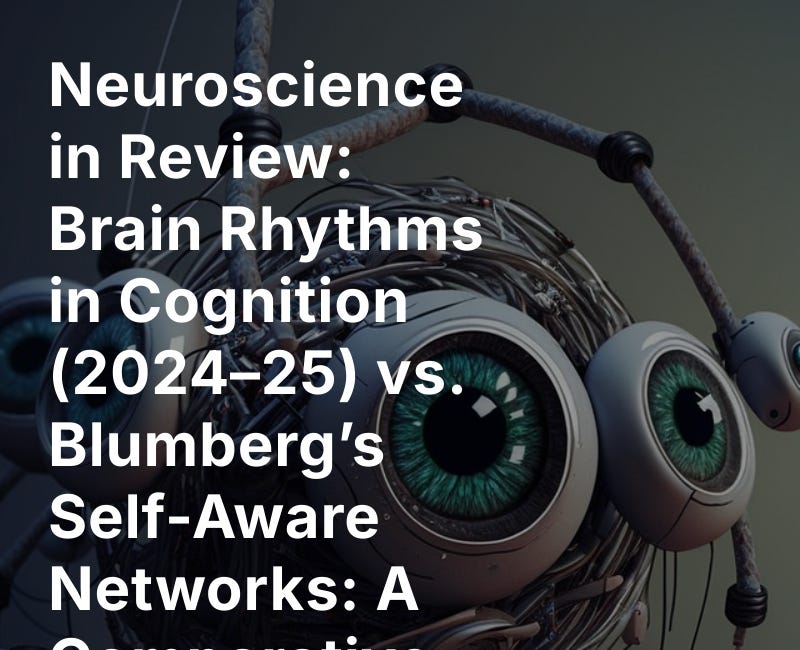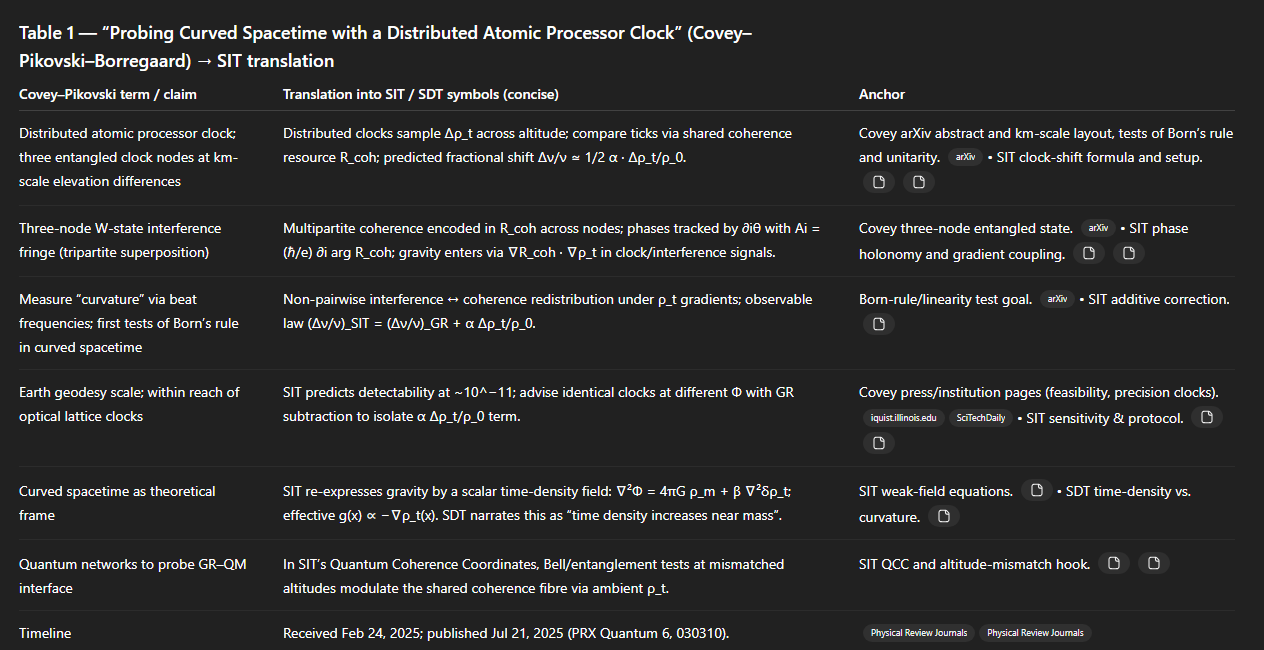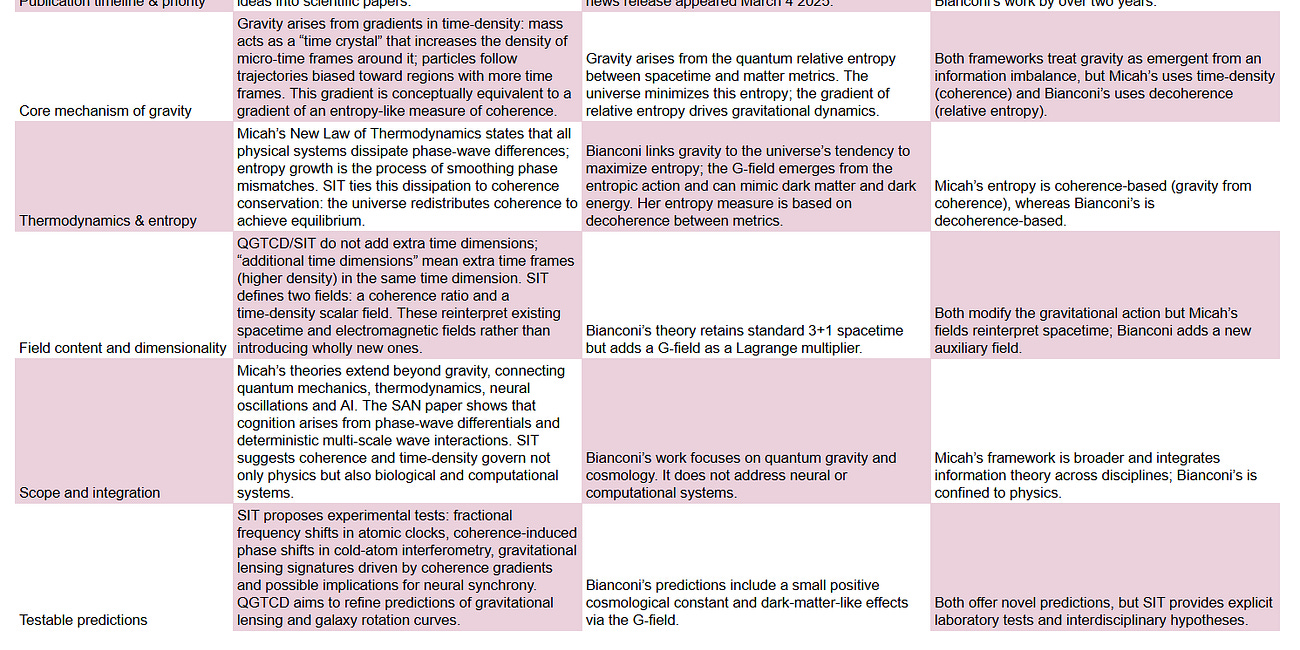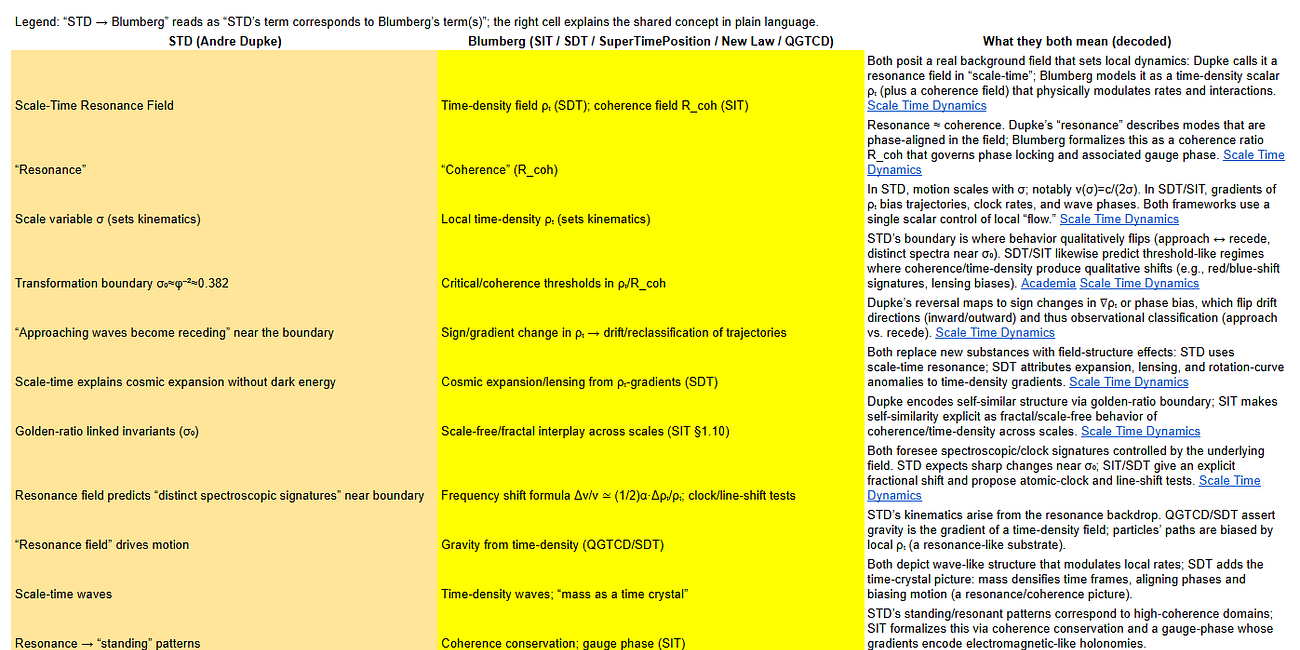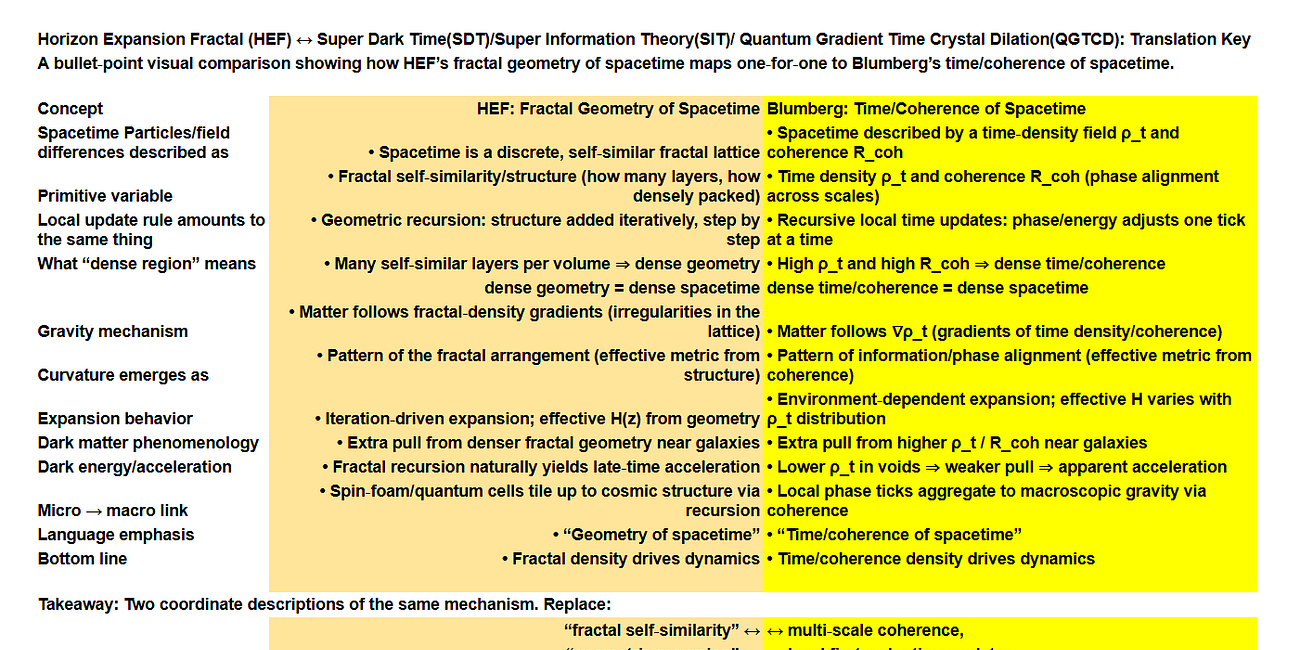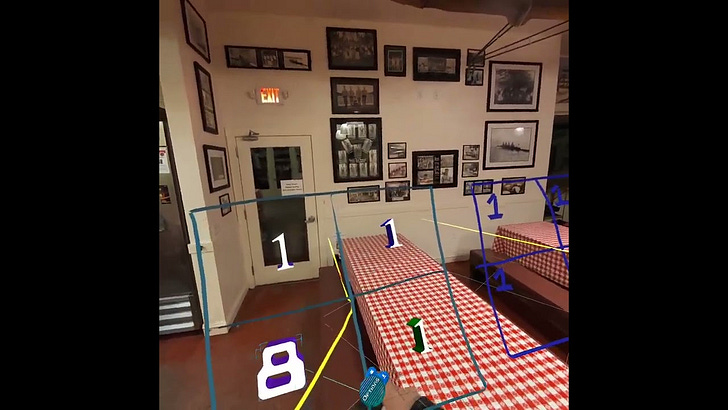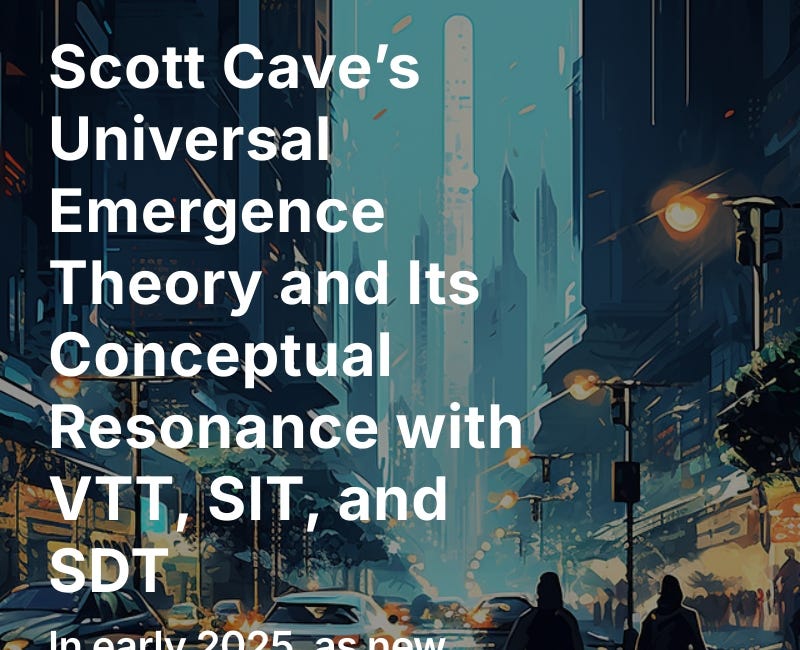The Architecture of Reality
Forging the Four Pillars of Super Information Theory
Every once in a while, in the quiet hum of research and the chaotic exchange of ideas, the pieces of a puzzle begin to click into place. Not just any puzzle, but one of the oldest in science: what is the fundamental nature of reality?
For years, since 2017, I’ve publicly advanced a sequence of ideas that crystallized into Super Information Theory (SIT). Quantum Gradient Time Crystal Dilation was introduced in 2022 with the core intuition that gradients in a time-density field govern gravitational effects. Super Dark Time introduced in 2024 on SVGN.io & on Github refined that intuition into a local scalar ρ_t(x) for the rate of temporal progression. SuperTimePosition contributed the coherence functional and phase-rate structure needed to speak about informational order at each point, R_coh(x). Micah’s New Law of Thermodynamics provided the dissipation, constraints, and conservation relations that tie coherence dynamics to entropy production. SIT unifies these strands in a single covariant action with dual primitives R_coh(x) and ρ_t(x), and it drives toward one standard: unique, testable predictions that connect quantum dynamics, gravity, and kinetics.
You can find the full, formalized scientific paper here:
Blumberg, Micah (2025). Super Information Theory. https://doi.org/10.6084/m9.figshare.28379318
Pillar 1: SIT 2.0 - A New Cosmology from Two Fields
The first consolidation was cosmological. SIT 2.0 posited two interacting informational fields: the coherence ratio R_coh, a dimensionless measure between 0 and 1 that captures local phase alignment and order; and the time-density ρ_t, a scalar field for the local rate of time’s flow.
Where coherence is high, clocks run slower; where decoherence dominates, clocks run faster. From a single master action, the large-scale anomalies of the universe cease to be mysteries and become properties of information. Dark matter appears as the gravitational signature of galaxy-scale coherence patterns in baryons and plasma, the gravity of information structured across the system rather than an unseen particle species. Dark energy reflects the natural behavior of the fields in the vast decoherent voids, where R_coh → 0 and the background expansion follows from informational dynamics rather than vacuum exotica.
The Coherence Ratio (R_coh): A number between 0 and 1 at every point in space, measuring the degree of local order and phase alignment. Think of it as a measure of how "in sync" reality is with itself.
The Time-Density (ρ_t): A field that describes the local rate of time's flow. Where coherence is high, time slows down. Where things are chaotic and decoherent, time speeds up. The ρ_t field originates in Super Dark Time and the coherence functional descends from SuperTimePosition; SIT2.0 made them the dual primitives of the action.
From this simple setup, and a single Master Action (the ultimate "rulebook" of the theory), the great cosmological mysteries began to resolve themselves not as strange additions, but as natural consequences:
Dark Matter wasn't a mysterious particle. It was the gravitational effect of the vast, galaxy-spanning patterns of coherence (R_coh) in the structure of stars and gas. It's the gravity of the information in the system's pattern itself.
Dark Energy wasn't a strange vacuum energy. It was the natural state of the SIT fields in the vast, decoherent voids of space, where R_coh approaches zero.
SIT 2.0 was a powerful cosmological model. It provided a new language for gravity and the universe's structure. But it was classical. It described the grand stage of the cosmos, but what about the actors—the quantum particles that live on that stage?
Pillar 2: SIT 3.0 - The Quantum Interaction Principle
The next step was to admit that coherence is not merely a background number. It is also a quantum observable. SIT 3.0 elevates R_coh to an operator R̂_coh acting on quantum states and links a system’s experienced time to both the gravitational background and its internal informational order:
dτ/dt = ρ_g(x) · exp[γ ⟨ψ|R̂_coh|ψ⟩].
Highly coherent, entangled states experience a measurably altered time rate relative to less coherent states in the same gradient. This is not a metaphor. It is a metrology-grade mechanism that maps informational structure onto timing observables. In this pillar I specified concrete experimental schemas, including distributed entangled-clock protocols sensitive to minute ρ_t gradients and coherence-dependent responses, without relying on any external theoretical scaffolding.
This equation is a mouthful, but its meaning is profound. It says the time a quantum system experiences (dτ/dt) is a product of two things: the background time set by gravity (ρ_g(x)) and an amplification factor determined by its own internal coherence (exp[γ * <ψ|R̂_coh|ψ>]).
Highly coherent states, like the GHZ states, fundamentally experience time flowing faster. The "entanglement amplification" wasn't just a clever experimental trick; it was a new physical law. SIT 3.0 bridged the quantum world of entanglement with the relativistic world of spacetime curvature.
Pillar 3: SIT 4.0 - Informational Energy Equivalence
With cosmology and quantum interaction joined, the remaining unification is energetic. A compact equivalence captures how information stores physical capacity:
ε_SIT = ζ · R_coh · [ρ_t]².
Here ε_SIT is the fundamental informational energy density and ζ is the informational-inertia constant defined in the formalism. Mass is not fundamental; it is the name we give to stable, localized informational energy. A particle such as the electron is a self-reinforcing knot of coherent information. E = mc² emerges as a special case of the deeper informational law once c is understood as the appropriate limit of causal propagation set by ρ_t.
This viewpoint aligns three domains at once. In physics, mass-energy equivalence is demoted to a corollary of informational dynamics. In cosmology, galactic “mass” tallies the energy stored in structured coherence. In neuroscience, transient, high-dimensional coherence patterns in the brain register as physically real informational energy flows, placing conscious dynamics on the same ledger as every other physical process.
This equation states that the fundamental energy density of any system (ε_SIT) comes not from its mass, but from its information dynamics—its coherence and its local time-density.
The Network Formulation of Super Information Theory
Many systems SIT speaks to are naturally networks: clock arrays, BEC lattices, superconducting qubit chips, cortical circuits, and the cosmic web. The network formulation makes this explicit by writing the theory on a graph and then showing how the continuum limit recovers the field equations used above.
Each node i carries three state variables: the time-density ρ_t(i), the coherence ratio R_coh(i), and a phase coordinate θ_i that tracks local informational phase. Each link (i, j) carries coupling strengths and, when relevant, a gauge term A_ij that accounts for transported phase. Define the node “informational charge” q_i = R_coh(i) · ρ_t(i). This single quantity makes conservation statements simple.
The network action splits into node and link parts. Node terms supply informational energy and targeted couplings to matter and electromagnetism, for example L_node(i) ∼ ζ R_coh(i) ρ_t(i)² + f₁(ρ_t, R_coh)·L_matter(i). Link terms encode transport and smoothness, for example L_link(i, j) ∼ K_ij[θ_i − θ_j − A_ij]² + D_ij[ln ρ_t(i) − ln ρ_t(j)]². In practice, I use a U_link potential that ties slow variations of ln ρ_t to variations of R_coh across edges so that coherence gradients and time-density gradients co-propagate while still allowing sharp domain walls where the physics demands them.
Varying the action gives a discrete conservation law on the graph. The central equation is a continuity relation for informational charge,
∂t q_i + Σ_j J_ij = 0,
with fluxes that follow directly from the link terms, for example
J_ij = −D_ij[ln ρ_t(i) − ln ρ_t(j)] − K_ij[θ_i − θ_j − A_ij].
This reveals two coupled transport channels: a diffusive channel in ln ρ_t and a wave-like channel in the phase differences. The same effective slope that clocks constrain in Pillar 4 maps onto combinations of D_ij and K_ij, so precision timing bounds immediately constrain network transport.
Taking the continuum limit, the graph Laplacian replaces Σ_j terms and one recovers the SIT field equations with ρ_t and R_coh coupled by targeted terms. The informational energy density remains ε_SIT = ζ · R_coh · ρ_t², now seen as the coarse-grained limit of the sum over node energies. This equivalence makes it straightforward to pass back and forth between device-level models and cosmological treatments.
The network view adds concrete experimental handles. In clock arrays, path-dependent phase around a loop is predicted to acquire a coherence-weighted redshift that scales with network diameter and average R_coh along the loop. In BEC lattices, cluster-level coherence modulates center-of-mass dynamics relative to matched thermal clouds, giving a clean route to the coherence–gravity drop test with tunable graph topology. In superconducting or cold-atom quantum processors, engineered K_ij and D_ij let you dial the relative strength of the wave and diffusive channels and read out SIT parameters from timing and phase transport.
It also connects naturally to Self Aware Networks. High-R_coh subnetworks function as informational attractors that store and route ε_SIT efficiently. This provides a mechanistic way to talk about agency and computation inside physical networks without leaving the SIT formalism.
Pillar 4: Ground Truth — Constraints and a Smoking-Gun Test
A theory is only as strong as the numbers it survives. I built SIT’s falsifiability in two passes.
First, constrain the couplings directly from the world’s best clocks. The same mechanism that ties R̂_coh to experienced time fixes a slope parameter that precision timing has already bounded. Those null results do not weaken SIT; they calibrate it and pin down an effective coupling α_eff tightly enough to make a clean, quantitative prediction.
Second, run the decisive drop test. The Coherence–Gravity Equivalence Test asks a simple question: does a hyper-coherent object fall with a measurably different acceleration than an incoherent one made of the same atoms in the same apparatus? A Bose–Einstein condensate versus a matched thermal cloud provides the cleanest comparison. The predicted differential is δa/g_E ≈ 10⁻¹⁵ at the benchmark couplings implied by present timing constraints. The number is small but unambiguous. See it and SIT wins a critical point. Miss it at the calibrated sensitivity and SIT, as formulated here, is falsified.
Provenance and Continuity
This architecture did not appear at once. It matured through Quantum Gradient Time Crystal Dilation, Super Dark Time, SuperTimePosition, and Micah’s New Law before consolidating as SIT 2.0, then SIT 3.0, and finally SIT 4.0. The chronology, interim drafts, and public claims are documented across my SVGN.io archive and the SIT manuscript record. The throughline is consistent: define ρ_t locally, formalize coherence as R_coh, write the covariant action with targeted couplings, quantize the interaction, and bind the free parameters to experiments that can close the loop.
The Journey Ahead
We started with a universe of things and arrived at a universe of patterns. The blueprint is complete enough to be tested and simple enough to teach: information organizes as coherence, time organizes as density, and their couplings generate what we call fields, forces, and matter. The task now is empirical. Tighten the clock constraints. Execute the coherence drop test. Push informational dynamics from a unifying story into a working standard.
Blumberg, Micah (2025). Super Information Theory. https://doi.org/10.6084/m9.figshare.28379318
“Micah’s New Law of Thermodynamics” (SVGN, Jan 27, 2025) was mirrored as Micah_s_New_Law_of_Thermodynamics.pdf on Jan 22–23, 2025. SVGN GitHub
2024-03-27 — “Explain it to me like I am six: QGTCD (Part 3).”
“The clock on the satellite is out of sync with the clock on earth.” svgn.io
“Explain it to me like I am six: QGTCD (Part 3)” (SVGN, Mar 27, 2024) was mirrored as QGTCDsix.md on Mar 28, 2024. SVGN GitHub
GitHub, selfawarenetworks/QGTCDsix.md, summarizes the core clock claim directly: gravitational potential affects clock time, and your UFT reframes this as changes in local clock rate of quantized time. GitHub
2024-03-28 — GitHub: QGTCDsix.md (commit history date).
“Satellites experience both effects: their clocks run slower due to high speed and faster due to being farther from [Earth].” GitHub GitHub
“Quantum Gravity’s New Frontier: Time, Density, and Information” discusses Ivette Fuentes–style quantum clocks in differing gravitational potentials as a test bed for the framework, tying clock behavior to gravitationally induced coherence changes. svgn.io
2024-10-21 — “Quantum Gravity’s New Frontier: Time, Density, and Information.” “Quantum clocks in curved spacetime can detect minute variations in spacetime curvature.” SVGN
GitHub backup note: There is related text in the repo under rawnote00.md that echoes the Engelhardt/Fuentes sections and topic, but I don’t see an exact-title mirror; treat it as a draft backup rather than a 1:1 mirror. github.com
2024-10-22 — “Dark Time Theory: A conversation…”
“Atomic Clocks in Varying Gravitational Potentials: High-precision clocks could detect minute time density effects.” svgn.io
It’s mirrored in the GitHub repo as rawnote05.md, last updated about nine months ago, and it carries the same “Dark Time Theory: A conversation…” material. GitHub GitHub
GitHub, selfawarenetworks/a0070z.md, links and notes “atomic-clock-relativity,” showing you were curating atomic-clock literature inside the repo while developing the tests. GitHub
2022-07-20 — GitHub: a0070z.md (updates).
“atomic-clock-relativity… Tags: dilation, gravity, redshift, time.” GitHub GitHub
The “Super Dark Time” index also surfaces “Introducing Quantum SuperTimePosition,” summarizing the internal clock-rate idea and its modification by gravitational time dilation, reinforcing your clock-based testing pathway. svgn.io
2025-01-27 — “Super Dark Time.”
“Clock Rate Shifts: Super Dark Time anticipates subtle differences in clock rates beyond… general relativity.” svgn.io
“Super Dark Time — Gravity Computed from Local Quantum Mechanics” (Jan 28, 2025) includes “Clock Rate Shifts” as a primary empirical signature, predicting subtle frequency differences beyond GR in stronger gravitational fields. svgn.io
“Super Dark Time” (SVGN, Jan 27, 2025) has no exact-title mirror located in the repo as of today. SVGN GitHub
2025-01-03 — “Wave-Dissipation Universality.”
“an altered local ‘clock rate’ modifies the action, shifting interference patterns.” svgn.io
“Wave-Dissipation Universality” (SVGN, Jan 3–4, 2025) has no exact-title mirror located in the repo as of today. SVGN GitHub
2025-01-05 — GitHub: raynote17.md (file added).
“The smaller clock gear represents the internal, rapid evolution of the particle’s wave state…” GitHub GitHub
“How Super Information Theory (SIT) undergirds the Schleier-Smith programme” (SVGN, Apr 19, 2025) was backed up later as QGTCD_SuperInformation.md on Jun 20, 2025. SVGN GitHub
GitHub, selfawarenetworks/raynote17.md, captures your “internal clock rate and synchronization” motif, which you connect to measurable clock-rate differentials under gravity. GitHub
For completeness: several GitHub notes that already appear in your appendix (e.g., raynote17.md added Jan 5, 2025; a0070z.md updated Jul 20, 2022; a0310z.md updated Sep 16, 2023; a0597z.md updated Jun 28, 2022) predate or parallel the SVGN pieces and include the clock-test language. GitHub GitHub GitHub GitHub
The Truth about Scale Time Dynamics
Introduction: Both André Dupke’s Scale-Time Dynamics (STD) and Micah Blumberg’s suite of time-centric theories (Quantum Gradient Time Crystal Dilation, Super Dark Time, Super Information Theory, New Law of Thermodynamics, and SuperTimePosition) propose that reality is underpinned by a
Dr. Gunther Kletetschka’s “3D Time” theory wasn’t the first 3D time theory,
Gunther Kletetschka’s "3D Time Theory" wasn’t the first framework to propose multiple dimensions of time.
Scott Cave’s Universal Emergence Theory and Its Conceptual Resonance with VTT, SIT, and SDT
Cave's theory centers around a core axiom called the Cave Law, which posits a fundamental upper bound on the density of information—defined by the Cave Constant Ξ, itself grounded in the Planck scale:
Why should the venue of publication determine the validity or worth of an idea in the first place?
Author Micah Blumberg’s work first appeared on GitHub, Figshare, Substack, and independent media well before “official” journals weighed in—or even noticed. If those timestamps establish his chronological lead, the next task is to examine whether the choice of medium undermines the integrity or impact of scientific discovery.
The stories of starving children in Gaza are real, and Israel is responsible for this crisis.
What's true about the narrative on Gaza right now? Is there really an issue of starvation that is caused by Israel's actions or is this terrorist propaganda infecting the UN, the BBC, the World Health Organization, and half of the world's news organizations?
and
Quantum Gravity's New Frontier: Time, Density, and Information
In the realm of theoretical physics, where the boundaries of human understanding are constantly pushed, two names have recently captured the attention of the scientific community: Ivette Fuentes and Netta Engelhardt. These accomplished physicists, while both working at the cutting edge of their field, approach the mysteries of the universe from fascinat…
New Unified Field Theory: Quantum Gradient Time Crystal Dilation: explains quantum mass as a time crystal dilating time at quantum scale & making gravity by increasing time frames.
Note the content of this article was originally published on github here is the link: https://github.com/v5ma/selfawarenetworks/blob/main/QGTCD.md
Dark Time Theory: A conversation about the core ideas forming a new frontier in physics.
Forward: ChatGPT o1-preview is much smarter and more skeptical than traditional ChatGPT 4o. It initially rejected my latest draft article on Dark Time Theory. So I had to reargue the basics from scratch, and I succeeded in persuading the model to my view.
Explain it to me like I am six: Quantum Gradient Time Crystal Dilation Theory. (Part 3)
I tried to explain my new Unified Field Theory while playing Population One on Meta Quest 3. They didn’t understand, so they asked me to explain to them like they were six. I decided to use Figmin XR to illustrate the idea.


